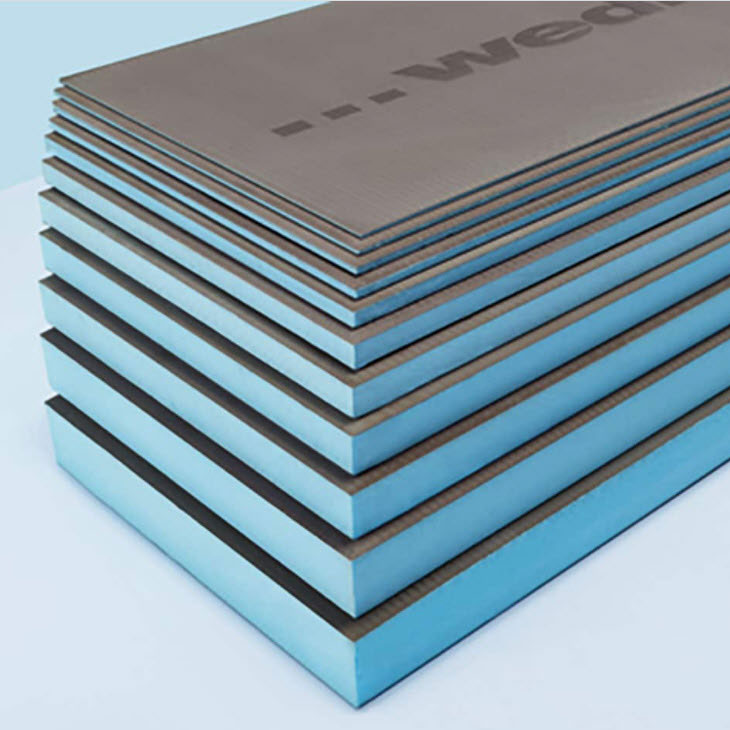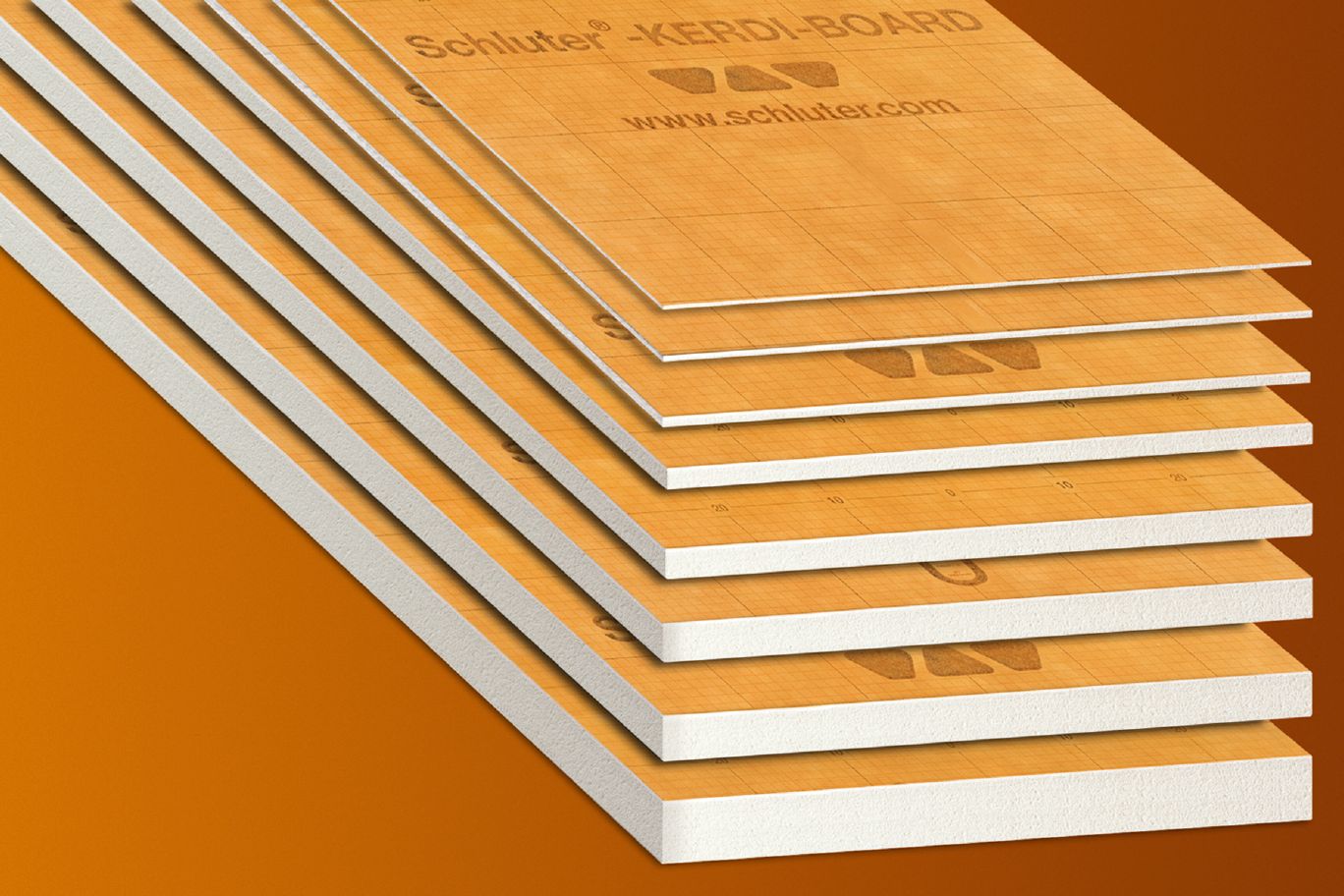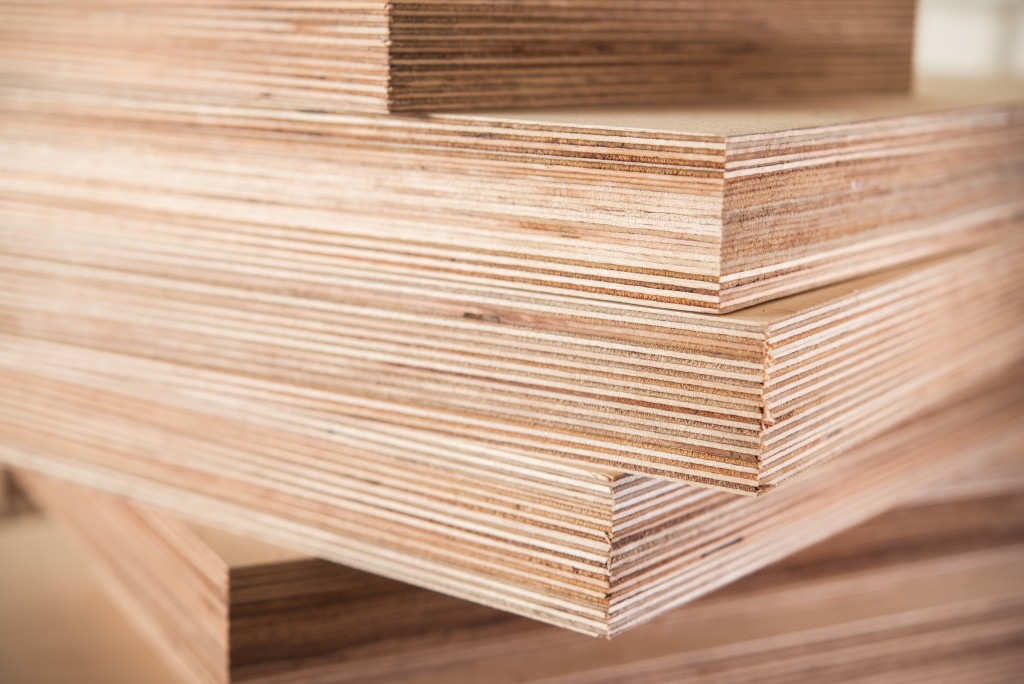What's Under the Porcelain?
Finding the Right Support For Installing Thin Materials
Previous page: Schulter Systems Above: Photo courtesy Roberto Colonetti
By K. Schipper
While a lot of countertop fabrication is a matter of laser measuring and precise cutting and milling, the situation isn't as cut-and-dried when supporting a porcelain or sintered-surface countertop. It might even best be summarized as whatever works for you. Certainly, the tile manufacturers make their recommendations if a large format product has been chosen for a floor, fireplace surround or shower. When it comes to countertops, though, opinions vary, and often what one person recommends is anathema to another. There are some things to keep in mind, though.

“Using the right glue is the most important part.”
Roberto Colonetti European Ceramics
Something for Everyone
The truth about porcelain is that it can be a real forgiving material, except when it isn’t. Use it on a wall or floor, and Schluter® Systems’ KERDI BOARD or wedi®’s Wedi Board will allow a contractor to complete an installation that’s straight and plumb and minimizes reflective surface noise. Under a porcelain countertop, though, it’s not everyone’s go-to substrate. Companies that supply porcelain in the U.S. recommend a variety of approaches, with both products being popular but by no means exclusive options. Other products in the market range from cement backer board, fiber cement board and glass mat gypsum board to water-resistant drywall and Styrofoam® backer board. Roberto Colonetti, manager of the porcelain division of European Ceramics in Perth, Australia, is one for whom Wedi Board has proven to be the best answer. However, he says it took some trial-and-error to get there. “For us, it’s one of the best in wet and dry areas with the best performance,” he says. “It’s very easy to work with, and easy to cut by hand or like we do by machine using a waterjet. Some other substrates can’t be cut using water.” That ability to stand up to water is important in a sink area, Colonetti adds. He also likes that the different thicknesses of Wedi can be used to make just the right thickness of subtop for each application, which also means it’s possible to use a 3.5mm or 6mm piece for a job, if necessary. “Of course, you have to respect the principles of construction by using the right sealant in the joints and the right glue,” he notes. Noah Chitty, director of technical services for Crossville, Tenn.-based Crossville, Inc., says that company recommends its 12mm product be used for countertops, and “you don’t necessarily need a substrate and a bond coat.” He adds that many other manufacturers of 12mm products do recommend a plywood subtop. That’s okay, he says, with some caveats. The biggest one may be in areas where moisture can be an issue. “For instance, theoretically you could leave out the piece of plywood above the dishwasher and use brackets or something similar in that space,” Chitty says. “Especially because you’ve got steam coming up, if you’ve got a wood product that obviously can swell and create instability.” “Our only recommendation for a sub-top with our product is Kerdi board or Wedi board,” said Michael Amendola, national technical manager for SapienStoneUSA. “All of which have a proven track record of withstanding zero to no water absorption, and a high level of flexural strength, which provides the stability and strength needed for a successful countertop installation. ‘If a plywood was to be used as a sub-top my recommendation is to only use a marine-grade plywood as it will provide more stability and much less absorption than a standard-grade plywood.” Colonetti also prefers to go with a marine grade plywood. “It’s a case where you have to use the right glue,” he says. “You have to allow the plywood and porcelain to move separately. Porcelain doesn’t make any kind of moisture, but the glue can. If we’re using a substrate like wood, we prefer to apply a layer of 4mm Wedi on top of it to give a cushion between the expansion of the board and the porcelain.”




“You wouldn’t want to bond it tightly to something else that may move.”
Noah Chitty Crossville Inc.
Secrets to Success
If trial-and-error could be said to have led Colonetti to Wedi Board, John Baltzegar III, founder and president of Hilton Head Island, S.C.-based StoneWorks, says his experiments have convinced him to utilize a honeycomb product under his porcelain countertops. “It has a lot of compressive strength,” says Baltzegar. “We’ve got in a 1” thickness and a ½” thickness. Our edge depends on what the customer wants. If they want a 2”, we put a 1” layer and a 1/2” layer underneath, and you’ve got a solid piece that’s very rigid.” The real secret to Baltzegar’s success, though, is that even when he’s using a 12mm porcelain, the application of the subtop is done in the shop and the entire assembly is transported to the jobsite. “In the shop, we have all kinds of vacuum lifts and we can handle the porcelain pretty easily without breaking it,” he notes. “But, once it’s fabricated, it’s got to travel.” He says the idea of putting down plywood, even topped with a foam product, and then setting the porcelain top over that just doesn’t make sense to him, especially because of the expansion and contraction of wood. Baltzegar says he’s been using his current approach for about a year and it makes sense to him. “Porcelain is the coming thing and I want to make sure that we’re fully invested in how to do it properly,” he says. “I want to do a job one time and do it right and it seems to be working, even though it might be a little more expensive and a little more laborious.” Like Colonetti, he also stresses the importance of using the right adhesive. In his case, Baltzegar says he uses a polyester resin similar to what’s used on fiberglass boats because the porcelain he uses has a fiberglass backing. SapienStone USA’s Amendola notes that his company tests and approves adhesives for optimum use with the company’s product, and also provides training and advice to fabricators. “Using the incorrect adhesive with the correct sub-top is just one example that can create problems,” he said. Still another option – in doing remodels – is to place the porcelain top over the existing countertop. “I can do it,” says European Ceramics’ Colonetti. “Again, using the right glue is the most important part. When we do things like that, we always add 4mm Wedi on top of it.” Crossville’s Chitty agrees it should only be done after consideration of the bonding method. “You wouldn’t want to bond it tightly to something else that may move,” Chitty says. “The mitered edge may need room to expand and contract. You’d leave a tiny gap against the mitered edge.” SapienStone USA’s Amendola also notes a major concern of putting porcelain on top of quartz surfaces – whether as an existing countertop or as a subtop. “Since quartz products have been around for many years now, many fabricators have an overabundance of scrap materials in their slab yards,” he said. “Due to the expansion and contraction of quartz, it should never be used as a support for a countertop whether it is for buildups, making miter edges, or framing underneath a countertop. Due to the amount of expansion, this material can crack the countertop material once is secured to the countertop with an adhesive.”

"Porcelain is the coming thing and I want to make sure that we’re fully invested in how to do it properly." John Baltzegar III StoneWorks

"Using the incorrect adhesive with the correct sub-top is just one example that can create problems." Michael Amendola SapienStoneUSA
Saving Face
Of course, the other option to doing a subtop is to do a drop-in with no subtop. Again, it’s not recommended. “When properly adhered to the cabinet boxes 12mm porcelain can be installed without a subtop,” Amendola says. “The only exception is the fabricator must use a continuous bead of glue and no span without support should be greater than 24-30.” “You can do it, but here the right skills will be imperative,” says Colonetti. “I’ve seen many jobs done in Australia with the wrong system, no allowance for expansion, not full coverage, etc. Many people are thinking that laydown of 300 X 300 tiles is the same for large panels, and it’s not.” There’s another good reason to use a subtop, and that’s to reduce the amount of effective surface noise or vibration after the installation. Again, it doesn’t seem as if one subtop offers more of an advantage than the next. “The glue plays an important role in that,” says Colonetti. “That and building all the stuff flat. You have to give it the right coverage of glue.” The bottom line: there is no generic answer to a best subtop for porcelain countertops. Or as Chitty puts it, it depends on whether the job is being done indoors or out, and who the slab manufacturer is, although it helps to work with the thicker materials. Don’t be afraid to experiment to find what works for you, advises StoneWorks’ Baltzegar. “Right now, we’re looking at using some KERDI BOARD,” he says. “It’s available in a lot of different thicknesses and we’ll try some of it and I’ll experiment some this summer.” Colonetti agrees that experimentation may provide the best answers, if it doesn’t come at a customer’s expense. “The important thing for us is to have a rigid substrate because the porcelain must sit flat on top without any deflection,” he concludes. “I’m always saying during my workshops, ‘If you don’t know how to do a job, don’t do it. You will save your face and your future in this market.’”